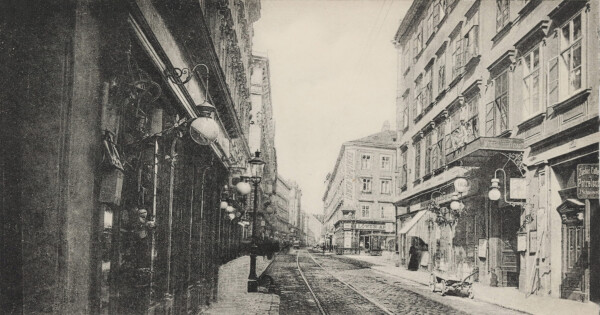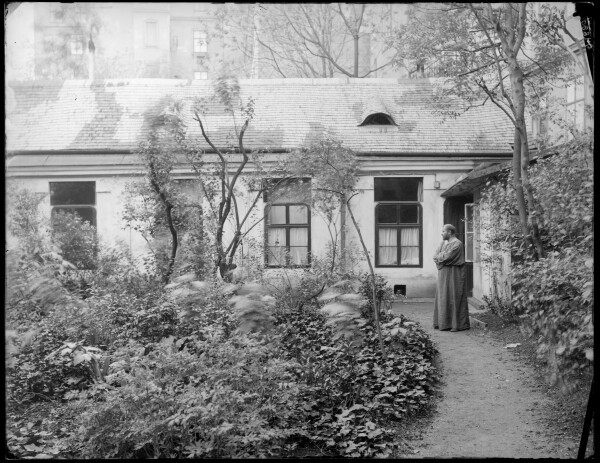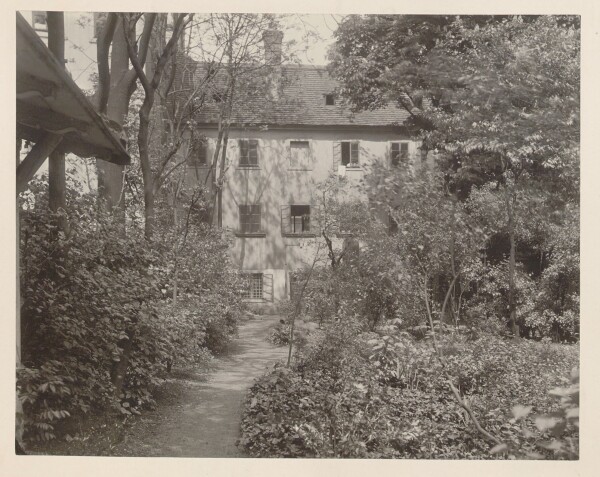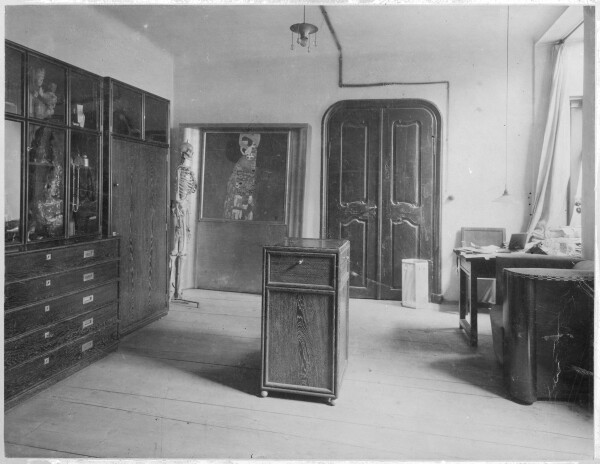Studio at Josefstädter Straße 21

View of Josefstädterstraße with the Theater in der Josefstadt, before 1905, Wien Museum
© Wien Museum

Moriz Nähr: Gustav Klimt in the backyard garden of his studio in Josefstädter Straße, May 1911, Österreichische Nationalbibliothek, Bildarchiv und Grafiksammlung
© Picture Archives and Graphics Department, Austrian National Library

Moriz Nähr: House in Josefstädter Straße, May 1911, Albertina, Wien, Widmung des Vereins der Freunde des Kunsthistorischen Museums
© The ALBERTINA Museum, Vienna

Moriz Nähr: Anteroom of Gustav Klimt's studio in Josefstädter Straße, May 1911, Österreichische Nationalbibliothek, Bildarchiv und Grafiksammlung
© Picture Archives and Graphics Department, Austrian National Library
In 1890, Gustav Klimt moved into his new studio at Josefstädter Straße 21 together with Ernst Klimt and Franz Matsch. Ernst died soon afterwards, and the studio cooperative disbanded a few years later. Franz Matsch left the studio to Gustav Klimt, who used it for 20 years.
After the Klimt brothers and Franz Matsch had started to enjoy financial success, they rented a studio in the 8th District of Vienna, at Josefstädter Straße 21, directly opposite the Theater in der Josefstadt. It was likely Franz Matsch, who lived and had grown up on the same street at number 23, who had become aware of the vacant building owned by Ferdinand Leonhardt. As Gustav Klimt later reported, the young artists never signed a written rental contract with Leonhardt but only entered into a verbal agreement.
Franz Matsch Moves Out
A mere two years after the artists had moved into the studio, Ernst Klimt died, leaving only Gustav Klimt and Franz Matsch to work in the new studio. From 1898 to 1907, Gustav Klimt used an additional studio on Florianigasse to work on the ceiling paintings for the auditorium of Vienna University.
Latest in 1905, what was left of the collective known as “Künstler-Compagnie” disbanded amidst the scandal surrounding the Faculty Paintings. Matsch and Klimt had to accept that their styles had drifted too far apart, making collaborations on joint commissions unthinkable. Moreover, Franz Matsch’s personal circumstances had changed drastically after marrying Theresia Kattus and building their own villa.
Already from 1897, Matsch had changed the address of his studio in the address register Lehmann’s Allgemeiner Wohnungsanzeiger to Silbergasse 60 (the studio situated in Villa Kattus, the residence of his wife’s parents). At the same time, he also appeared in Lehmann’s as a member of the studio collective “Franz Matsch und Gebrüder Klimt” [Franz Matsch and the Klimt brothers], which was registered at Josefstädter Straße 21. We can assume that from 1897, he used the studio on Josefstädter Straße only sporadically.
Two years later, Matsch had the addition “Fr. Matsch und Gebr. Klimt” removed from his entry in Lehmann’s, and changed his address to his newly built Villa Matsch, which had an adjacent studio. While the “Maler-Atelier Franz Matsch und Gebrüder Klimt” [painters’ studio Franz Matsch and Klimt brothers] continued to appear in a separate entry in Lehmann’s until 1902, the group had likely unofficially disbanded already in 1899. From 1902 to 1904, Klimt was registered as a painter only at his home address at Westbahnstraße 36 (presumably as he mostly worked out of the Florianigasse studio), with an entry of the studio at Josefstädter Straße 21 only reappearing later. This new entry now mentioned Gustav Klimt as the sole artist working out of the studio. It seems that at some point between 1899 and 1905, Franz Matsch had finally moved out of the studio, leaving it to be used by Gustav Klimt alone.
The controversy surrounding the Faculty Paintings, which was exploited by the press, drew a lot of unwanted attention, causing Klimt to retreat into the seclusion of his studio. As opposed to other contemporary artists, he kept his workplace hidden from the public. The small, one-floor Biedermeier house, tucked away in an idyllic backyard with garden, certainly accommodated Klimt’s reticent nature.
The Studio’s Interior and Exterior
Prior to its demolition in the summer of 1912, the photographer Moriz Nähr, who was friends with Klimt, thankfully documented the interior and exterior of the studio in Vienna’s Josefstadt District in photographs. Additionally, the appearance of the building can be reconstructed based on descriptions by Klimt’s contemporaries.
The studio, known as a “garden pavilion,” at Josefstädter Straße 21 was a small, one-floor house built in the Biedermeier style, which inconveniently only had windows along one of its side walls. For an artist’s studio, especially, this one-sided incidence of light was not particularly advantageous. The well-kept backyard garden, however, provided the artist, who was known for his love of nature, with a place of tranquility and a source of inspiration.
The house’s interior boasted three workrooms situated one behind the other, originally intended to be used by each artist of the “Künstler-Compagnie.” Nähr’s photographs show furnishings designed by Klimt’s friend Josef Hoffmann and executed by the Wiener Werkstätte as a present for the painter. They included a large cabinet, a small chest for painting utensils, a desk and armchair, a light fixture, as well as set of a table with two chairs. The correspondence between Gustav Klimt and Marie Zimmermann tells us that these furnishing only arrived at the studio in late 1903. Klimt, who was a creature of habit, appears not to have been too happy about the change, which had been intended to be a surprise gift: “The gentleman from the Cottage quarter [N.B. likely Fritz Waerndorfer] wanted to do up the studio at his own expense in my absence, as a surprise […] but the caretaker didn’t let him and asked me instead – it was all I could do to frustrate his, in principle, laudable intentions – I absolutely cannot have this at present, what with all my work and my agitation; the plan was put off until after the exhibition.” The furniture was moved in only once the collective exhibition “Klimt-Kollektive” had finished in 1903. Hoffmann’s plans to transform the studio into a “showpiece” Jugendstil room (including wallpapers, floors, curtains etc.), however, was rejected by Klimt.
Living and Working in the Josefstadt District
Klimt created many of his chief works at the Josefstadt studio. The deaths of his father and brother in 1892, and the dissolution of the “Künstler-Compagnie,” had plunged Klimt into an existential crises which led to an artistic reorientation. While he was working at Josefstädter Straße 21, Klimt created all the works from his Golden Period, left the Künstlerhaus, and became a founding member of the Secession. In his monumental works, The Beethoven Frieze (1901/02, Belvedere, Vienna) and The Stoclet Frieze (1905–1911, private collection), he united artisan craftwork and painting, and thus revolutionized the understanding of art of his time.
Klimt often stayed at his studio for days on end. Numerous letters to friends and relatives show that he used his workspace as his main place of residence, asking them to write to and visit him at his studio rather than at his apartment. Seeing as he disliked change, it must have been all the harder for the artist when his landlord Ferdinand Leonhardt sold the house in 1911 despite verbal assurances to the contrary. He forced Klimt to clear out the studio during the summer months, as the building was to be demolished. Shortly afterwards, Gustav Klimt moved into his new studio at Feldmühlgasse 9 (now no. 11), which he would use until his death.
Literature and sources
- Sandra Tretter, Peter Weinhäupl, Felizitas Schreier, Georg Becker (Hg.): Gustav Klimt. Atelier Feldmühlgasse 1911–1918, Vienna 2014.
- Mona Horncastle, Alfred Weidinger: Gustav Klimt. Die Biografie, Vienna 2018.
- Herbert Giese: Franz von Matsch – Leben und Werk. 1861–1942. Dissertation, Vienna 1976.
- Sandra Tretter, Peter Weinhäupl (Hg.): Chiffre: Sehnsucht – 25. Gustav Klimts Korrespondenz an Maria Ucicka 1899–1916, Vienna 2014.
- Adolph Lehmann's allgemeiner Wohnungs-Anzeiger. Nebst Handels- u. Gewerbe-Adressbuch für d. k. k. Reichshaupt- u. Residenzstadt Wien u. Umgebung, 33. Jg. (1891), S. 779.
- Adolph Lehmann's allgemeiner Wohnungs-Anzeiger. Nebst Handels- u. Gewerbe-Adressbuch für d. k. k. Reichshaupt- u. Residenzstadt Wien u. Umgebung, 39. Jg., Band 1 (1897), S. 701.
- Adolph Lehmann's allgemeiner Wohnungs-Anzeiger. Nebst Handels- u. Gewerbe-Adressbuch für d. k. k. Reichshaupt- u. Residenzstadt Wien u. Umgebung, 47. Jg., Band 1 (1905), S. 1213.
- Adolph Lehmann's allgemeiner Wohnungs-Anzeiger. Nebst Handels- u. Gewerbe-Adressbuch für d. k. k. Reichshaupt- u. Residenzstadt Wien u. Umgebung, 41. Jg., Band 1 (1899), S. 734.
- Brief von Gustav Klimt an Maria Zimmermann (October 1900). S64/13.
- Alfred Deutsch-German: Im Atelier Gustav Klimmt's, in: Neues Wiener Journal, 01.10.1899, S. 4.
- Hans Koppel: Bei Gustav Klimt, in: Die Zeit, 15.11.1903, S. 4-5.

